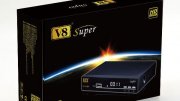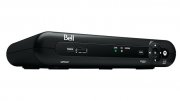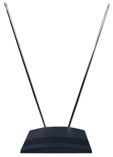 Ever since the transition to digital television, most consumers have had more choices in free over-the-air broadcasting. However, when a viewer has difficulties receiving DTV signals, a traditional solution may be the best one: getting a TV antenna. This guide provides information on TV antennas and tips for obtaining good quality reception of digital broadcasts.
Ever since the transition to digital television, most consumers have had more choices in free over-the-air broadcasting. However, when a viewer has difficulties receiving DTV signals, a traditional solution may be the best one: getting a TV antenna. This guide provides information on TV antennas and tips for obtaining good quality reception of digital broadcasts.
Scanning for DTV Channels
Before making any changes to your current antenna or antenna system, you should perform a channel scan to see if your antenna receives the digital signals being broadcast in your area.
To run a channel scan, find the "set-up" or "menu" button on your remote control, then select the option that allows you to search for available digital broadcast channels. Once the scan is complete, you should be receiving all available digital channels in your area. In many cases, this is all you need to do to watch DTV broadcasts. You should rescan periodically to check whether additional digital channels have become available.
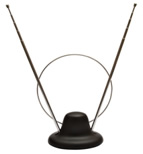 If you have any difficulty completing the channel scan, consult the owner's manual of your digital-to-analog converter box or DTV for detailed instructions.
If you have any difficulty completing the channel scan, consult the owner's manual of your digital-to-analog converter box or DTV for detailed instructions.
Antennas for Receiving DTV
To receive DTV signals from all stations in the area, your antenna needs to be able to receive both VHF channels (channels 2-13) and UHF channels (channels 14-51). Some antennas only provide good reception of VHF or UHF channels, but not both. For example, indoor "rabbit ears" usually need to be augmented with an additional "wire loop" or "bowtie" antenna (see images below) in order to pick up signals on UHF channels. Many of the antennas being sold as "HDTV Antennas" perform best at receiving UHF signals, but actually perform less well receiving VHF channels. Check with retail consultants and consumer websites to make sure that any antenna you choose provides good reception of both VHF and UHF channels.
Even if you use a digital-to-analog converter box, you will still need to use an antenna to receive DTV signals. While both analog and DTV sets come equipped with antennas to receive TV signals, digital-to-analog converter boxes do not contain additional antennas or signal amplification.
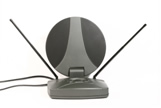 Antennas for Different Conditions
Antennas for Different Conditions
The antennas shown below will work for the indicated signal strength in most instances, but may not work in all cases. The type of antenna needed at a specific location may vary depending on geographic location, the height at which the antenna is used and other local factors such as nearby buildings, trees, terrain or home construction. Generally, an outdoor antenna will get better reception than an indoor antenna.
|
|
|
Reception Tips
- Antennas typically need to be oriented or "aimed" to get the best signal from the desired station. DTV reception can often be improved just by changing the location of your current antenna, even as little as a few inches. For example, moving it away from other objects or placing it higher or lower can often improve reception. Be sure to move the antenna slowly as digital TV tuners need a little time to properly detect the signal.
- While adjusting your antenna, it may be helpful to access the "signal strength meter" on your digital-to-analog converter box or DTV to determine whether your adjustments are improving the signals' strength. The signal strength meter is usually accessed through the menu feature on your remote control; consult the owner's manual of your device for detailed instructions on how to access it.
- Remember to do another channel scan after you have adjusted your antenna. For outdoor antennas, a rotor that re-orients the antenna can improve performance, particularly when trying to receive stations that transmit from different locations.
- If you are near a station's broadcast tower, reception of that station, as well as other stations, can be impeded by strong signal "overload."
- If you are not receiving certain DTV stations, this does not necessarily mean there is a problem with your antenna or receiver. Check with the TV station to find out whether they are planning changes that will improve reception. To check available signals where you live, use the FCC's DTV reception maps.
Source: www.fcc.gov

|
AmazonBasics Ultra Thin Indoor TV Antenna - 35 Mile Range Speakers (AmazonBasics)
|

|
Vilso TV Antenna Outdoor Amplified - Motorized 360 Degree Rotation - Digital HDTV Antenna - 150 Miles Range - Wireless Remote CE (Vilso)
|
Related posts:



